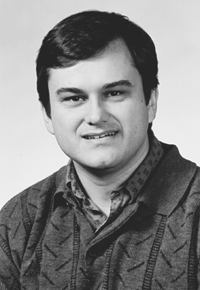![[Currents header]](/homeart/currents_header.gif)
![[Currents header]](/homeart/currents_header.gif)
September 29, 1997
Researcher Dennis Zaritsky will study the evolution of the Milky Way's nearest neighbors in space

|
|
Dennis Zaritsky
|
For the fourth consecutive year, a UCSC researcher has captured one of the nation's most prestigious honors for young faculty members: a David and Lucile Packard Fellowship for Science and Engineering, worth a total of $500,000.
Astronomer Dennis Zaritsky, age 33, will receive $100,000 per year for the next five years to support his innovative research on the life histories of stars in two nearby galaxies. He is among 20 scientists and engineers chosen by the Packard Foundation for their exceptional promise and unusual creative abilities.
UCSC is one of just four institutions that have earned at least one Packard Fellowship each year for the last four years. The others are the California Institute of Technology, the University of Chicago, and UC San Francisco.
"These generous fellowships to our recently recruited faculty attest to the continuing quality of UC Santa Cruz faculty," said UCSC Chancellor M.R.C. Greenwood. "These fellowships are exceptionally competitive and indicate that our young researchers are second to none--and their accomplishments enhance the high-quality research and teaching at UCSC."
Zaritsky, an assistant professor of astronomy and astrophysics and an assistant astronomer at UC Observatories/Lick Observatory, joined the UCSC faculty in 1994. He earned his B.S. in physics from Caltech and his Ph.D. in astronomy from the University of Arizona. Before coming to Santa Cruz, Zaritsky held a Hubble Postdoctoral Fellowship at the Carnegie Observatories in Pasadena.
Zaritsky's research addresses one of astronomy's fundamental questions: How did galaxies evolve? One way to tackle that issue is to examine as many individual stars in a galaxy as possible. Their ages, temperatures, brightnesses, and other physical properties reveal much about how the overall galaxy has changed through time. However, such studies are impractical for our own Milky Way, because we cannot see all of its stars. Most other galaxies are too far away for astronomers to resolve many of their stars.
Fortunately, two nearby galaxies offer a way around this problem. They are the Milky Way's closest galactic neighbors: the Large Magellanic Cloud and the Small Magellanic Cloud, visible from the Southern Hemisphere as gauzy blobs hanging in the sky.
Zaritsky and his colleagues use a special instrument attached to a 40-inch telescope at Las Campanas, Chile, to take extremely detailed pictures of sections of each Magellanic Cloud. Zaritsky designed the instrument, called the Great Circle Camera, specifically to produce undistorted images of large swaths of the sky. His team is about one-third of the way toward its goal of collecting images of about 25 million stars in the clouds--the most extensive stellar survey yet attempted.
"We hope to trace the histories of star formation in the Magellanic Clouds, which are stepping stones toward understanding the evolution of galaxies in general," Zaritsky said. "They are the only galaxies that we can deconstruct into their constituent stars in such detail."
The team's early analysis already has pointed to "percolations" of starbirth throughout the clouds, possibly triggered by waves of supernova explosions. The research also may yield tantalizing clues about the nature of the "dark matter" suspected to cocoon our Milky Way and other galaxies.
Zaritsky expects his project to last about five years. Funding from the Packard Foundation will allow him to upgrade his computer equipment and data-storage capacity. He also plans to hire another postdoctoral researcher for data reduction and scientific analysis.
The David and Lucile Packard Foundation of Los Altos invites about 50 universities to nominate two faculty members each for the fellowships. Now in its 10th year, the program has awarded $100 million to young scientists and engineers across the country, in disciplines ranging from molecular biology to astrophysics, from computer vision to climate change.
Other Bay Area recipients of 1997 Packard Fellowships are Thomas H. Lee, assistant professor of electrical engineering at Stanford; Wendell A. Lim, assistant professor of pharmacology at UC San Francisco; and David S. Weiss, assistant professor of physics at UC Berkeley.
"This group of Packard Fellows represents an investment in talented young faculty," said Lynn Orr, dean of earth sciences at Stanford University and chairman of the fellowship advisory panel. "Their research will benefit society in the decades to come, and the students who work with them will make contributions that will multiply the value of the research effort many times over."
The five-year unrestricted fellowships also encourage novel research by freeing recipients from standard government-funding processes, Orr noted. "This approach reflects David Packard's style of operation--find talented people and give them the resources they need to do top-quality work, along with the responsibility to determine how best to use those resources," Orr said.
The David and Lucile Packard Foundation, created in 1964, supports and encourages organizations that depend on private funding and volunteer leadership. It awards grants to programs in the arts, community, marine biology, conservation, population, education, and children's health.